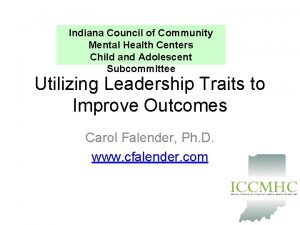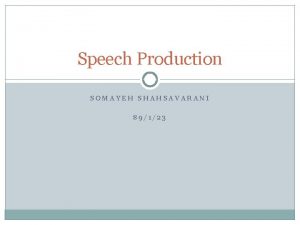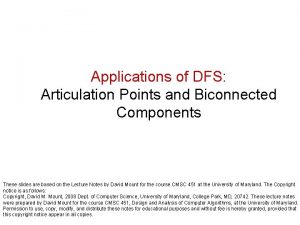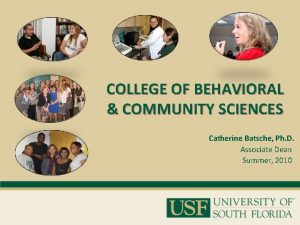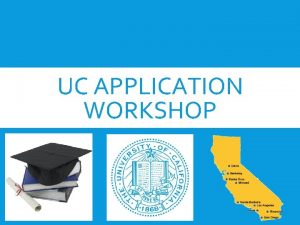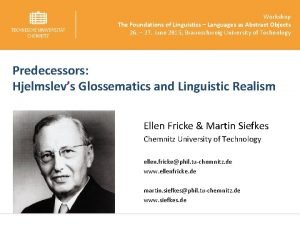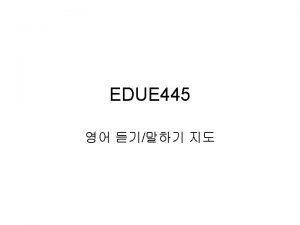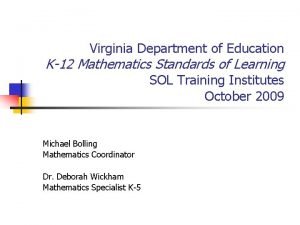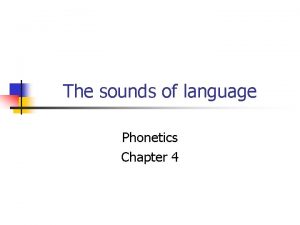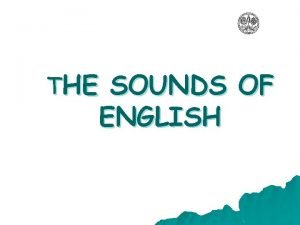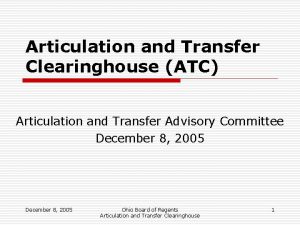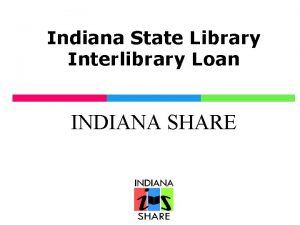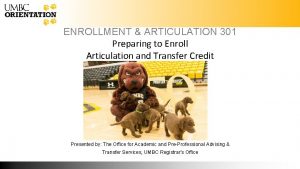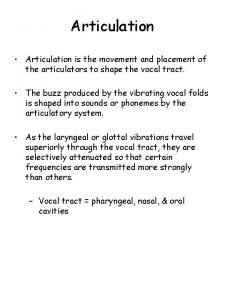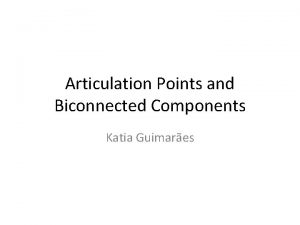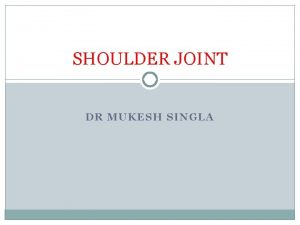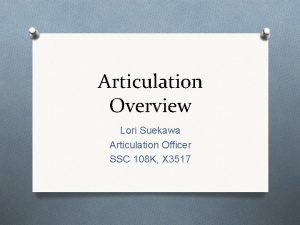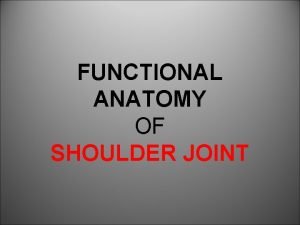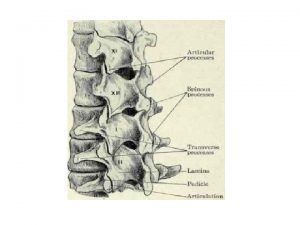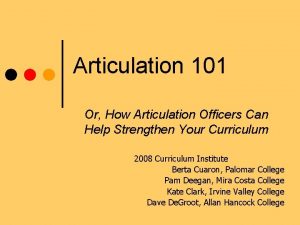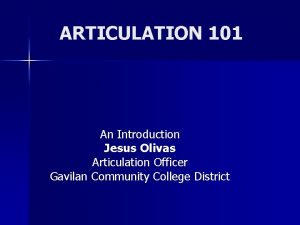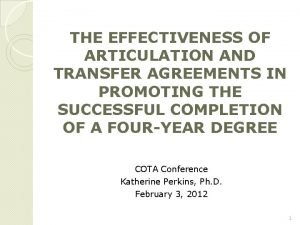Transfer and Articulation In Indiana The Community College
















- Slides: 16

Transfer and Articulation In Indiana The Community College Perspective

Current State § Transfer. IN website assists students to identify Current State course applicability in multiple institutions § Core Transfer Library delineates institutional commitments to accept courses in transfer § STAC (State Transfer and Articulation Committee) works to develop transfer agreements and practices § Transfer in Indiana is primarily course by course

Transfer from Ivy Tech § Associate of Science (AS) is primary transfer degree (first transfer in 1989) § Associate of Applied Science (AAS) is primarily a terminal degree with limited transfer options (except course by course) § Associate of Arts first offered in 2005 but very few graduates § 512 distinct articulation agreements with different 65 college and university partners

Transfer from Ivy Tech § Of Ivy Tech’s 57 programs, 74% have transfer Transfer from Ivy Tech agreements – One agreement for Health Information Technology – 135 agreements for Liberal Arts – 55 different agreements in Business Administration § Most university transfer agreements have been limited to a single Ivy Tech campus and based primarily on course-by-course transfer

Course Transfer Library (CTL) § Ivy Tech offers 74 CTL courses Transfer (CTL) § Course 85% of CTL Library courses are accepted without conditions § 15% have conditions § Some CTL courses are accepted as undistributed credit rather than direct equivalents § Actual implementation/compliance with CTL agreements is not universal

What is Working? § Transfer opportunities have increased dramatically in past four years (most activity in 2007) § From FY 2004 -5 to FY 2006 -7, total transfers from Ivy Tech increased by 133% (2, 119 to 4, 944) § Model agreements have been established: – AS in Nursing to BSN completion agreements – AS to BS in Business Administration at IU-East – AS to BS in Engineering Technology with Purdue, statewide – AS to BS in Education statewide agreements with IU and Ball State (though very different paths

Principal Challenges § Incredible complexity causing – Confusion and uncertainty for students – Uncertain process for student appeals – Tens of thousands of hours to develop and maintain hundreds of agreements § Excessive variation in university curriculum, including no common lower division general education core – CHE position in Reaching Higher is to support a common general education core to simplify transfer



Spanish Transfer Map § 12 different pathways – difficult for students and advisors Spanish Transfer Map § Technical core requirement ranges from 6 to 20, while total credit hour requirement varies from 62 to 70 credit hours § Common required courses limited to 6 classes, although 75% will accept 14 of the same CTL courses to meet degree requirements § Variance in mathematics high, ranging from requiring MATH 118 to allowing most CTL math class § Science – most variance in acceptance of CTL chemistry and least amount in biology as a choice or requirement § Outliers – two require or accept GEOG 207; one requires FIT 100; two require CINS 101 § Regional campus agreements are different at both IU and Purdue

Additional Challenges § Inconsistent implementation in transferring CTL Additional at Challenges courses department level § Course by course agreements result in 2+3 transfer, hidden prerequisites, lengthening time to degree § Few incentives (and actual disincentives) for students to complete associate degrees prior to transfer

Inconsistent Application of CTL § Inconsistent 15 percent exceptions application of CTLin CTL § Even with university-level agreement, departments do not always comply with CTL agreements, (recent examples in Psychology, Economics, Medical Terminology, Math) § Problems and inconsistencies not regularly referred to STAC for resolution § No clear appeals process nor ombudsman

Incentives/Disincentives for Degree Completion Incentives / Disincentives for Degree Completion § Departmental letters/communications advising students not to complete degrees at Ivy Tech prior to transfer § Limited 2+2 guaranteed transfer agreements § No preference in articulation, admissions, nor scholarship availability for associate degree completers upon transfer

Best Practices in High-Performing States § Statewide course catalogs, systems to inform students regarding transfer § Statewide core curriculum guaranteed in transfer (common general education core) § Statewide common course numbering or mandated compliance with course applicability systems § Designated ombudsmen for transfer and student-friendly appeals process § Incentives (admissions, transfer and scholarship aid) to students to complete associate degrees prior to transfer

Ivy Tech Efforts to Simplify Transfer § Decreasing variation in program curricula and core textbooks § Establishing a common general education core curriculum (Reaching Higher goal) § Converting all transfer agreements to statewide agreements that guarantee transfer of at least 60 credit hours that meet degree requirements (no more 2+3 agreements) § Encouraging degree completion prior to transfer § Participating in data systems to track students and evaluate transfer student performance

Overcoming Myths with Data § Myths – Community college courses Overcoming Myths with Data are less rigorous – Community college faculty are less qualified – Transfer students do not do well academically at fouryear institutions § Rebuttal – Improved data on community college transfer performance – State data systems to track performance of transfers – Data necessary to create a culture that supports effective and efficient transfer
 Indiana council of community mental health centers
Indiana council of community mental health centers What are the 4 processes of speech production?
What are the 4 processes of speech production? Hanau quint
Hanau quint Phonation and articulation
Phonation and articulation Phonation and articulation
Phonation and articulation Biconnected components and articulation points
Biconnected components and articulation points A wave is a disturbance that transfers
A wave is a disturbance that transfers Usf college of behavioral and community sciences
Usf college of behavioral and community sciences Connecticut college transfer
Connecticut college transfer Ivc transfer center
Ivc transfer center Double articulation
Double articulation Duality in linguistics
Duality in linguistics Vdoe math vertical articulation
Vdoe math vertical articulation Facettes costales
Facettes costales Speech sounds in phonetics
Speech sounds in phonetics Manner of articulation
Manner of articulation Pure vowels
Pure vowels
